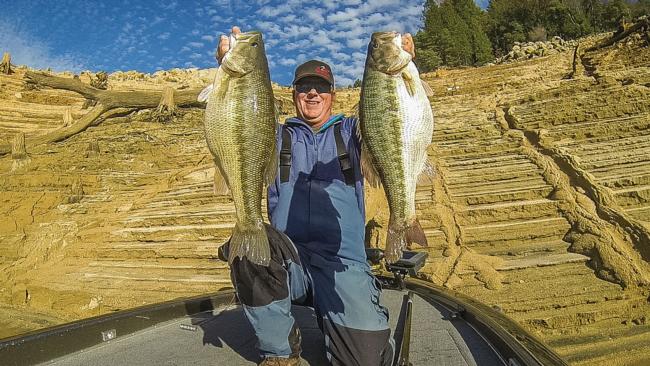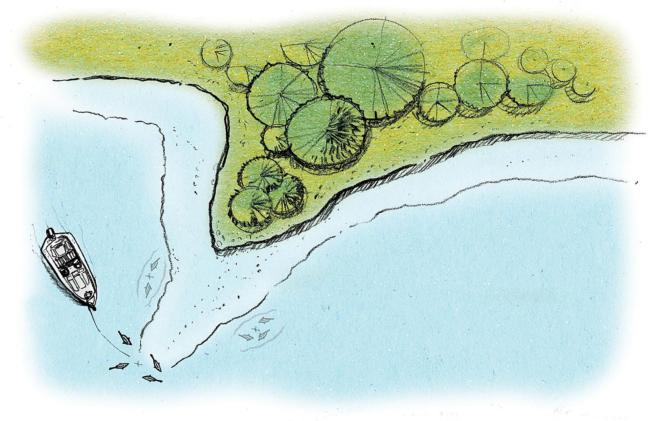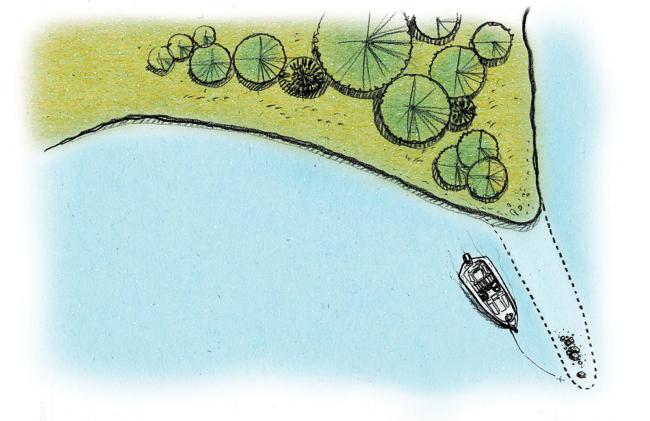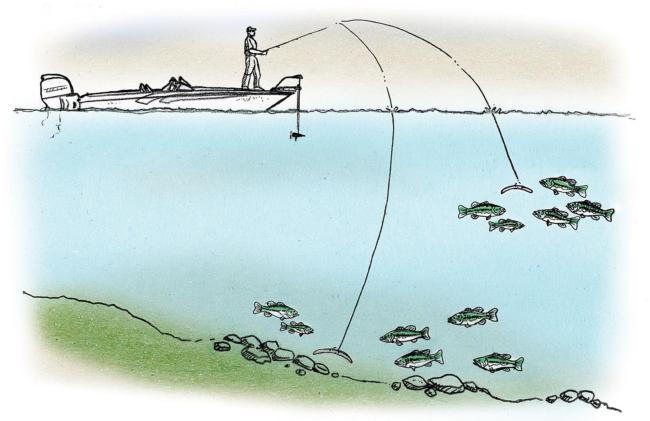Slob Spots
Move over, largemouths, world-record-class SPOTTED BASS are stealing the fishing spotlight
(Editor's note: This article originally appeared in the 2015 February issue of FLW Bass Fishing magazine. To read more compelling articles from FLW Bass Fishing magazine each month, become an FLW subscriber member.)
“Go West, young man” once defined the nation’s theme of growth and expansion. Now, it’s the battle cry of anglers seeking giant spotted bass. Indeed, the stocking of Alabama spots in California lakes in the mid-1970s was the genesis of an incredible success story. Like many others that have migrated to the West, these transplants have most certainly made it big.
How big? Well, 6-pounders – the minimum for California’s Trophy Black Bass Program that recognizes, tracks and manages for trophy-class bass – are fairly common; 7s and 8s won’t shock anyone, and the occasional 9 is not unheard of.
Topping the recent evidence of California’s trophy spot production was Keith Bryan’s 10.48-pound New Melones Lake mule – a pot-bellied spot caught in February 2014 that eclipsed the world record of 10.27 pounds set by Bryan Shishido on Pine Flat Lake (also in California) in 2001. (Editor's note: Since this article was penned, the record has been broken by Nevada angler Lou Ferrante with a 10.95-pounder caught from Bullards Bar. FLW pro Paul Bailey of California also recently caught an 11-4 fish that may or may not be recognized as the record.)
On these lakes, as well as other Western spotted bass powerhouses such as Shasta, Oroville and Whiskeytown, the spring spawn finds Western anglers regularly sacking up 30-plus-pound bags when these feisty footballs move shallow. But even with spots spending the rest of the year mostly suspending over deep water, that catch-of-a-lifetime potential looms ever present.
Cody Meyer has firsthand knowledge of the potential of Western spotted bass fisheries. In May 2014, he won a local tournament on Bullards Bar Reservoir in California with a 40 1/2-pound limit of all spotted bass. His sack of spots included fish weighing 7.14, 7.46, 7.80, 9.01 and 9.10 pounds.
“It was incredible – 40 1/2 pounds of all spotted bass, and that was during tournament hours,” Meyer says.
Max Fish, environmental scientist for the California Department of Fish and Wildlife’s fisheries branch, notes that the stocking of Alabama spots followed the 1937 introduction of Kentucky spotted bass originating from Ohio brood stock. Genetic mixing of the two subspecies probably occurred in most California lakes where spots are present, he thinks, but it’s safe to assume which side of the family contributed most to the whoppers caught in recent years.
“It would be hard to say for certain that any fish is purely an Alabama-strain spot,” Fish says. “It’s likely that those larger fish probably have a higher degree of Alabama [genetics], but statewide, it’s kind of a mixed bag.”
The rise in fame of California’s trophy spotted bass potential begs an interesting question: If all those Alabama spotted bass are growing to trophy proportions in their new Western home, can the Southeast still produce a world-record fish? If so, what “ingredients” are necessary for it to happen, and how can an angler get a legitimate shot at catching one?
That’s what we decided to find out by reaching out to some of the best spotted bass anglers across the country.
Spot-On Habitat
What does it take to grow trophy spotted bass? Three factors stand out.
1. Deep, Clear Water
The depths and clarity of California’s mountain reservoirs, and similarly the mountain reservoirs of the Ozarks and Blue Ridge regions among others in the Southeast, afford spots plenty of room to spread out and hide like needles in an aquatic haystack, while maintaining generous sight-feeding clarity.
“With spotted bass being visual predators, anytime you can slant the table for using vision to locate prey it benefits the predator’s feeding ability,” Fish says.
In fact, Patrick O’Rourke, a Georgia Department of Natural Resources field biologist, points to the rapid expansion of spotted bass in West Point Lake during the 1990s that coincided with efforts to clean up Atlanta’s wastewater discharge into the Chattahoochee River. West Point is one of the Chattahoochee’s impoundments. As phosphorous levels decreased, spot numbers and sizes in the lake increased – a verification of the impact of water clarity.
2. Forage
Most spots in the Eastern range dine on threadfin shad, gizzard shad and blueback herring. However, Appalachian mountain lakes such as Burton Lake in Georgia and a host of Western reservoirs are growing huge spots that are snacking on prey that helps them quickly pack on the pounds – juvenile trout and salmon.
“I think these Western lakes hold some of the best spotted bass fisheries in the world,” Meyer says. “I think the reason is that we have these lakes such as Whiskeytown and Bullards Bar that have the kokanee, which is a land-locked sockeye salmon, while others such as New Melones, Folsom and Shasta have trout.
“Both of these forage species are really high in protein, and they just create the ultimate monster,” he continues. “Everyone knows how aggressive spots are and how much they eat. Well, they’re just eating all these protein bars constantly. It’s the recipe for giant spots.”
“Spots as a species don’t typically get this big,” adds Fish, referring to the obese bass that seem to show up with increasing frequency at tournament weigh-ins on California lakes. “It takes a pretty significant factor such as an abundance of nutrient-rich food sources for them to reach such size. With the food sources they have in California, they get bigger at a younger age.”
3. Low Pressure
Geographic isolation protects some reservoirs from the heavy fishing pressure endured by many more popular favorites. This is especially true of several California reservoirs and likely contributes to the “catchability” of some trophy-class spots.
Also, many Western spots don’t have a lot of competition for food. In the East, spotted bass in some lakes share the water with competitive species such as striped bass as well as largemouths and smallmouths.
Ambitious Outlook
Considering the small margin by which the New Melones spotted bass cinched the record, many anglers are looking for another newsmaker soon.
Where the next showstopper will be hooked is fodder for spirited discussion. Could the next record spot bend a rod east of the Mississippi, in a lake such as Burton where rumor has it that a world record was once caught, mistaken for a largemouth and then released? Or will the next several years see subsequent records reported from the Pacific Time Zone?
“If we can grow an 8-plus-pound fish in Georgia, then genetically the fish have the ability to reach record size,” O’Rourke says. “It’s just a matter of them finding enough food without burning too much energy to pack on the pounds.
“There’s nothing saying that the next record couldn’t come out of the East, but the conditions in some of those Western lakes are just very good.”
For FLW Series Western Division pro Gary Dobyns, there’s no debate: “I expect the record to change five or six times in the next couple of years unless someone catches a 12-pounder, and I believe they will all come out of Western lakes.”
The Everyman’s Fish
He’s caught 54 largemouths weighing more than 10 pounds each, including a 17-pounder, but California guide and devout trophy hunter Matt Allen is jazzed about spotted bass. Acknowledging the fish’s history as a somewhat underappreciated species, Allen says the recent explosion of heavyweight spots has finally pushed this bass to the forefront.
News of 2014's new world-record fish and many subsequent catches in the 8- and 9-pound range have set the fishing world abuzz, but Allen is quick to point out that the pursuit of the next spotted bass record is no esoteric Everest reserved for the elite few. Rather, spotted bass – even the big ones – are fish for the masses.
“Fooling numbers of giant spotted bass is extremely difficult, but to fool one, to get your ‘fish of a lifetime,’ is easier than getting your 10-pound largemouth,” Allen says. “This is because most trophy largemouth bass are single-minded in their forage base. They may be a trout eater, a crawdad eater or something completely different, but whatever they are, they don’t vary much unless survival dictates they do.
“Spotted bass, on the other hand, are opportunistic,” he continues. “I assume some of that comes from the size of their mouth. They are capable of eating trout, kokanee, gizzard shad, etc. when available, but because of their physical size it’s much easier for them to eat shad, smelt, crawdads, worms, bugs, etc.”
Practically, Allen says that means you might catch a world-class spotted bass on a 4-inch plastic worm just as easily as you might on a trout swimbait. That also implies less demanding tackle requirements – anyone with a medium-action spinning rod could potentially net a trophy spotted bass.
Scoring a stud spot comes down to right place-right time, but again, your odds are much higher with spots than with largemouths.
Big-Spot Tactics
Matt Newman Gives Them the Slip
Deep, long points are classic spotted bass structure, but if you want to intercept more jumbo spots, don’t be afraid to stray away from the obvious parts of the structure where bass are most prominent on your electronics.
“A lot of times, bigger spots will sit on the sides of points, making them harder to graph,” says pro Matt Newman. “My five biggest spots were all caught off the graph when there were just a few big marks on the tip of a point.”
Cody Meyer’s 1-2 Punch
Seeking to imitate a trout or kokanee, Cody Meyer throws an 8-inch Huddleston swimbait over long, flat points with isolated rocks or sharp breaks at the ends where spots can ambush prey. Early morning or overcast conditions are best for fooling wary fish.
Gear Notes: Be willing to use line as light as 4- to 8-pound-test fluorocarbon for spooky spotted bass. If the swimbait falters, he follows up with a wacky rig.
Presentation Key: Casting to deep water and retrieving back to the shallows suggests a meal about to get away and triggers a reaction strike. Conversely, spots might follow a lure retrieved from shallow to deep without biting.
Gary Dobyns Nails It
Western pro Gary Dobyns knows the versatility of a wacky-rigged Yamamoto Senko for spotted bass in deep water. If the fish are feeding near the bottom, he’ll go after them with a Senko that has a 3/64-ounce nail weight inserted into one end of the worm so it falls vertically and stands up for an enticing display in clear water.
Rigging Tip: Hook under a rubber O-ring for maximum bait life.
Lighter Approach: For targeting spots suspending in open water, or those moving up and down a bluff wall, remove the nail weight for a slower horizontal fall.



